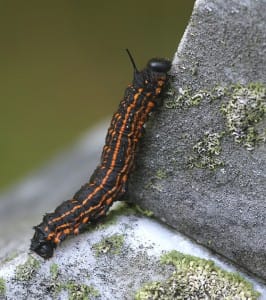Source(s): Gary R Peiffer
Orange-striped oakworms(Anisota senatoria) are often found on oak trees and other hardwoods in late August and September. They are usually recognized in the caterpillar stage because of their defoliation of oak trees.

The full grown caterpillars are 1 1/2 to 2 inches long, black in color with several narrow, yellow-orange longitudinal lines. Behind the head are a pair of stiff, blunt spines, about the thickness of the body. The remaining segments of the body have pairs of smaller spines. The orange-striped oakworm caterpillar generally appears in Georgia in August, September and sometimes as late as October. They defoliate sections of various oak species and sometimes completely defoliate smaller trees. This insect is extremely troublesome when present in oaks over patios, driveways, sidewalks, etc. because of the large amount of excrement from the insect’s body.
The winter is passed in the pupa stage in the ground. Adult moths emerge from June to August, mate and deposit eggs on the undersides of foliage on host plants.
Usually, there is only one generation per year and control measures are not necessary. If, however, control measures are necessary, such as to protect a small seedling oak, treat with Dipel or Thuricide (both are Bacillus thuringiensis, a biological control) or use an insecticide such as cyfluthrin or Sevin.
Information: Georgia Forestry Commission Metro Forestry
Reproduced by: DeKalb County Extension
Resource(s): Insect Pests of Ornamental Plants
Center Publication Number: 30
- Carrying and Transporting Chainsaws - October 18, 2016
- How To Prepare Samples For Handling - September 24, 2013
- Identification and Prevention of Termite Problems - September 24, 2013